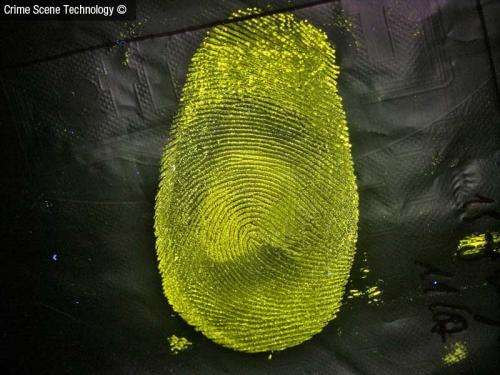Novel technique to detect fingerprints

An innovative product that uses fluorescence to detect fingerprints has been developed by a team from the Laboratoire de Photophysique et Photochimie Supramoléculaire et Macromoléculaire (CNRS/ENS Cachan) in collaboration with the specialized French firm Crime Scene Technology. This new product, Lumicyano(tm), will make it possible to highlight fingerprints directly, more rapidly and at a lower cost, avoiding the cumbersome processes required until now. The product has been successfully put through its paces by the French Police and Gendarmerie as well as by Scotland Yard and the FBI. It has led to a publication on the website of the journal Forensic Science International and a patent has been filed.
Fingerprints are essential evidence in numerous criminal investigations. However, scientific police can find it difficult to make use of such fingerprints when they are too light or their contrast is too low. When someone places their finger on an object, they leave behind a trace composed of water, salts, fats, amino acids and, potentially, DNA. To reveal this latent trace, the most widely employed technique is fuming of a cyanoacrylate compound, better known as "Super Glue". This reacts with the elements present in the fingerprint and polymerizes, leaving a white deposit that technicians can then photograph and analyze. However, this technique can at times entail certain difficulties. For example, when the fingerprint support is of light color, the contrast with the fingerprint is too low to be photographed. Similarly, if the fingerprint is very light, the deposit will be too tenuous to obtain an exploitable image.
In this case, crime scene investigators can opt for a second treatment using a colorant, which turns the fingerprint fluorescent. However, this post-treatment poses several problems. The products in question are toxic and carcinogenic and have to be used in a fume cupboard, whose cost is usually beyond the means of most police stations. In addition, this process can require up to 48h and can degrade the fingerprints through leaching, which in most cases compromises the sampling of DNA.
In a bid to overcome these problems, numerous chemists have been trying for the past three decades to come up with a product allowing fluorescent fingerprints to be detected directly. This has now been achieved and researchers from the Laboratoire de Photophysique et Photochimie Supramoléculaire et Macromoléculaire (CNRS/ENS Cachan), in partnership with the specialized firm Crime Scene Technology, were the first to do so while complying with the standard conditions of use of a conventional cyanoacrylate. To manage this, they combined cyanoacrylate with a molecule of the tetrazine family, the smallest fluorescent colorants known to date. Tetrazine molecules are fumed along with the cyanoacrylate onto the fingerprint support and adhere to the deposit. In this way, using a simple UV lamp or forensic lighting techniques (see footnote 1), the fluorescent traces are visible and can be photographed.
Lumicyano offers excellent detection performance. In addition, it reduces costs and treatment times. Another advantage is that it does not destroy the DNA that can sometimes be extracted from fingerprints. Its operational efficiency has been successfully tested and validated, not just by the French Police and Gendarmerie but also by several other police forces throughout the world such as Scotland Yard and the FBI. Already available in numerous countries, Lumicyano(tm) is generating increasing interest among CSIs the world over. It will be presented at the forthcoming Worldwide Internal State Security Exhibition (Milipol, Paris 2013), scheduled for 19-22 November 2013 in Paris Nord Villepinte.
More information:
Lumicyano(tm): A new fluorescent cyanoacrylate for a one-step luminescent latent fingermark development, Cosimo Prete, Laurent Galmiche, Fifonsi-Gwladys Quenum-Possy-Berry, Clémence Allain, Nicolas Thiburce, Thomas Colard, Forensic Science International, Volume 233, Issues 1-3, 10 December 2013, Pages 104-112
dx.doi.org/10.1016/j.forsciint.2013.07.008
Journal information: Forensic Science International
Provided by CNRS




















